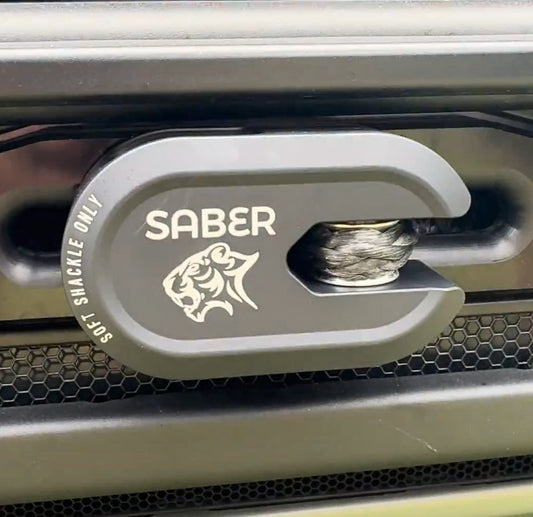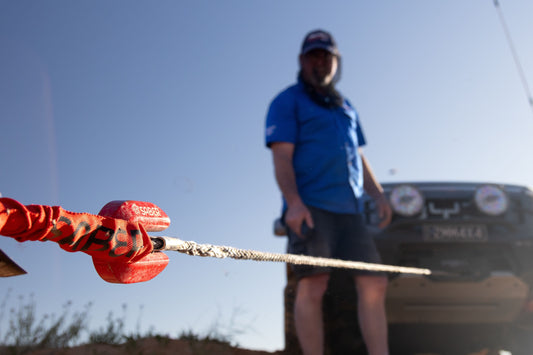How to Choose the Right Kinetic Recovery Rope (Using the Saber Range)
When your 4WD sinks into mud or sand, a kinetic recovery rope is often the fastest, smoothest, and a safe way to get moving again. This guide keeps it beginner-friendly and practical, using Saber Offroad’s rope range as your reference. You’ll learn what makes kinetic ropes special, the simple physics behind choosing the right size, and exactly which rope maps to your rig’s weight.
What Is a Kinetic Recovery Rope—and Why It’s Better
A kinetic rope is purpose-built to stretch (up to ~30%) under load. That controlled stretch is the secret: instead of a painful “yank,” the rope stores the towing vehicle’s momentum and releases it smoothly, pulling the stuck vehicle free with less shock to both vehicles.

Smooth stretch = controlled force. The rope absorbs energy and protects vehicles and occupants.
Think bungee jumping: a stretchy cord slows you down gently rather than stopping you abruptly. A kinetic rope does the same for your recovery—less spike, more control. That’s easier on recovery points, chassis, and necks.
Plain-English Physics (no degree required)
The towing vehicle carries kinetic energy: E ≈ ½ × mass × speed². The rope acts like a spring. More stretch means the energy is absorbed over a longer distance, so the peak force is lower. Longer stopping distance = gentler loads. That’s why a true kinetic rope with ~30% stretch feels night-and-day smoother than the old snatch strap.
The Golden Rule for Sizing: 2× to 3× Your Vehicle’s GVM
To choose the right rope, start with your vehicle’s GVM (loaded weight). The practical rule is simple:
Pick a kinetic rope with a Minimum Breaking Strength (MBS)
around 2 to 3 times your vehicle’s GVM.
Why this range?
- Too weak (much under 2×): risks over-stretch or failure.
- Too strong (well over 3×): won’t stretch enough, acting almost static—bigger shock loads, less control.
Always size to the lighter vehicle in the recovery. If a Hilux (lighter) is recovering a Landcruiser (heavier), choose based on the Hilux’s GVM so the rope actually stretches when the lighter rig applies the pull. While we suggest always having the rope for your vehicle, if you travel often with the same group of mates its worth looking at this.
Match Your Vehicle to the Right Saber Rope
Saber’s kinetic ropes are 9 m long, built from heavy-duty double-braided Nylon 66, and engineered for up to ~30% stretch. Here’s a quick mapping you can trust:
| Saber Rope | Typical Vehicle Class | Example GVM Range | Why This Size |
|---|---|---|---|
| 4,000 kg | Light 4x4s, compact SUVs | ~1.2–2.0 t | Gives meaningful stretch for lighter rigs (e.g., Jimny) while maintaining a solid safety margin. |
| 8,200 kg | Most dual-cab utes & mid-size wagons | ~2.5–4.0 t | The all-rounder for Hilux/Ranger/Prado/D-MAX class. Sweet-spot of stretch + strength. |
| 12,500 kg | Heavy wagons & touring builds | ~4.0–6.0 t | For big wagons (LC200/300, Patrol) and loaded tourers that need more energy capacity. |
| 16,000–18,000 kg | Very heavy 4x4s & light trucks | ~5.3–8.0 t | For expedition rigs and commercial 4x4s where loads and suction are significant. |
| 22,000 kg | Extreme/heavy off-road vehicles | ~7.3–11.0 t | For Unimogs, off-road service trucks, and severe-duty scenarios. |

Tip: If you regularly tow or carry heavy accessories, calculate with your loaded weight. Better still, weigh your rig at a public weighbridge to remove the guesswork.
“But Can’t I Just Buy the Biggest Rope?” (Short Answer: No)
Oversizing sounds safe, but a rope that’s far stronger than your GVM won’t stretch much under your pull. That means higher, sharper forces into chassis and recovery points, and you’ll need a harsher run-up to make it work. The 2×–3× guideline exists to keep recoveries controlled and gentle—which is the whole point of kinetic ropes.
Mini Math: Why 30% Stretch Wins
The first peak load in a smooth kinetic pull scales like F ≈ (m × v²)/(ε × L), where ε is stretch and L is rope length. Increase usable stretch from 20% to 30% (with the same mass and speed) and you increase stopping distance by 50%, which reduces peak force by about a third. More stretch = lower peak = safer, smoother recoveries.
Real-World Technique: Make the Rope Do the Work
- Pre-load the rope: Take up slack before the pull so the stretch comes on smoothly (avoid a “hit”).
- Use modest approach speeds: 10–15 km/h is typically plenty when the system is set up right.
- Reduce resistance first: Dig, clear axles, air down, use boards—every bit of reduced suction lowers peak loads.
- Keep lines straight: The rope should run as straight as possible between rated points.
- Clear the zone: People 1.5× rope length away, with a damper on the rope.

Quick Selector: Which Saber Rope Should I Buy?
Use this quick map if you’re just getting started:
- Small 4x4 / Jimny / compact SUV (≈1.2–2.0 t): Saber 4,000 kg
- Most dual-cab utes & mid-size wagons (≈2.5–4.0 t): Saber 8,200 kg
- Heavy wagons & tourers (≈4.0–6.0 t): Saber 12,500 kg
- Very heavy 4x4s / light trucks (≈5.3–8.0 t): Saber 16,000–18,000 kg
- Extreme heavy vehicles (≈7.3–11.0 t): Saber 22,000 kg

If you’re between categories, consider how you usually travel (solo & light vs towing & fully loaded) and pick accordingly. When in doubt, talk to your local Saber stockist—they’ll confirm the right size for your build and how you use it.
FAQ (Beginners)
Q: Do I really need a kinetic rope if I have a tow strap?
A: A tow strap is fine for gentle towing on firm ground. A kinetic rope is designed for bog recoveries—its stretch gives you controlled force and momentum, making difficult pulls smoother and safer.
Q: Can I connect to a tow ball?
A: No. Only use rated recovery points. A tow ball can shear off and become a projectile.
Q: How fast should I go?
A: Usually 10 – 15 km/h. It usually doesn’t take much speed if the setup is right; let the rope’s stretch do the work.
Q: Soft shackle or steel shackle?
A: We recommend soft shackles for kinetic recoveries. They’re strong, light, won’t rust, and are less hazardous if something fails.
Ready to Rope In Your Rescue?
Choosing the right kinetic rope is simple: use 2–3× your GVM, size to the lighter vehicle, and let the rope’s stretch deliver smooth, controlled force. The Saber Offroad range covers everything from compact 4x4s to heavy off-road rigs—engineered for real-world conditions with safety front and centre.

SABER The Gear To Get You Home..
To find a Saber stockist near you click here.
To find the Kinetic Rope Kits online click here.
References (Safety & Guidance)
Guidelines for safe use of Vehicle Recovery Straps | Snatch Straps





